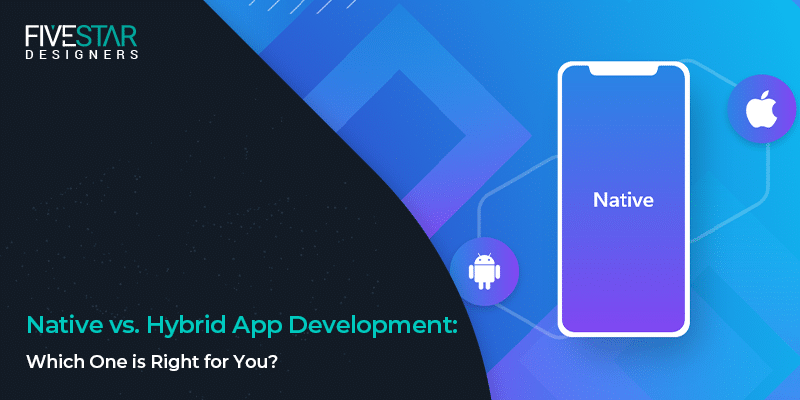Introduction
Businesses and entrepreneurs seeking mobile application development must decide between native apps and hybrid apps as their primary choice. The two mobile app development choices present different benefits and technical hurdles, which affect app performance, expenses, development timelines, and user experience standards.
Native apps deliver superior performance through optimized user interfaces, yet hybrid apps help businesses execute mobile development quickly at reasonable costs. No proper selection becomes possible without understanding how different these two technologies actually are. This blog examines native and hybrid apps to assist you in selecting the best solution that suits your business requirements.
What is a Native App?
Mobile app development teams create native applications for a single operating system by using programming languages that are platform-specific, such as Swift or Objective-C for iOS and Kotlin or Java for Android. The app uses device software and hardware features to optimize the user experience while running.
Pros of Native Apps:
High Performance: Native mobile applications operate with excellent speed and functionality because their development specifically targets one OS platform.
Enhanced Security: Operating system apps benefit from native security mechanisms because they originate from the OS development environment.
Better User Experience: App user interfaces and experiences work better when native apps use guidelines for each platform to create interfaces users can understand easily.
Offline Functionality: The operating system functionality of native applications continues working as long as the app does not require an internet connection.
Full Access to Device Features: Native apps deliver automatic access to device hardware functionality, which includes GPS sensors, camera devices, and other sensors without any limitations.
Cons of Native Apps:
Maintenance Complexity: Two different codebases for maintenance operations present significant resource challenges because updates and maintenance require extensive work.
Higher Development Cost: The cost and time of development increases for app developers when choosing a specific platform, such as Android or iOS.
Longer Development Time: Building versions independently extends development times because different versions need to be developed.
Larger Storage Space: Native apps occupy extensive storage space since they incorporate performance-enhancing optimization features.
Skilled Developers Required: The requirement for experienced UK developers increases because native development requires coding skills that align with distinct programming languages for specific platforms.
What is a Hybrid App?
Developers create hybrid mobile applications by writing code in web technologies such as HTML and CSS and JavaScript before applying a native app container. The development of these applications starts once and enables deployment across different platforms, which leads to lower development expenses.
Pros of Hybrid Apps:
Lower Development Cost: A single mobile application created for multiple platforms allows businesses to reduce their development expenses.
Cross-Platform Compatibility: By using a single codebase, your applications function simultaneously on the Android and iOS systems, therefore minimizing development time and expenses.
Easy Maintenance: Easy codebase maintenance experienced by app agency and requires less expense and is streamlined through updating one central database.
Faster Development: A hybrid app takes developers less time to construct compared to spending time on native app development.
Web-Based Technologies: Web-based technologies enable web developers to develop apps using familiar systems that enhance their ability to create mobile applications.
Cons of Hybrid Apps:
Limited Access to Native Features: A couple of device features are unavailable for basic accessibility or need extra plugin software.
Performance Limitations: The web-based framework of hybrid applications creates performance limitations, which result in less smooth execution than native applications.
Slower UI/UX Experience: Hybrid applications deliver slower user interface and user experience performance, thus affecting user satisfaction metrics.
Challenges with Complex Applications: Hybrid applications struggle to execute complex features such as advanced graphics and animations and real-time tasks.
Dependency on Third-Party Tools: Third-Party Tool Frameworks such as React Native, Flutter, and Ionic pose constraints in application development.
Multiple Elements Must Be Considered When Picking Between Application Types
- Development Budget: A limited development budget together with fast deployment for both the iOS and Android markets can be achieved through hybrid applications.
- Performance Needs: Native apps represent the superior option when your performance requirements include high-speed operations because they deliver better application performance.
- User Experience Expectations: A commitment to offering excellent user experience calls for native applications since they deliver superior design elements alongside better performance interactions.
- Time Constraints: Companies face time constraints frequently and hybrid apps offer prompt development and quick release timelines which are suitable for urgent execution.
- Scalability & Future Growth: During your evaluation consider the extent to which your app requires regular updates together with complex functionality and deep device feature integration.
Conclusion
The solution between native and hybrid apps depends entirely on your business requirements as well as your budget allocation and project schedule. Your analysis of specific requirements enables you to develop an informed decision which guarantees your app aligns with your business objectives over the long term. Your app success is heavily influenced by your decision to develop native apps or hybrid apps.



